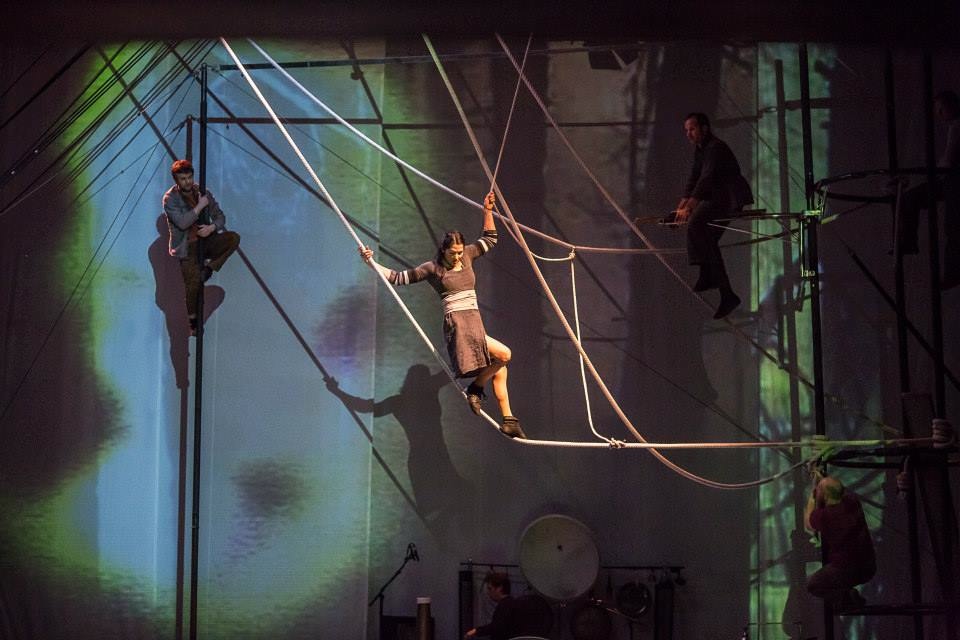Green, ochre and violet washes of light and blurry images of leaves and branches projected onto the back wall. Shadows of crouched figures poised high and low in a metal ‘tree’. A forest of ropes slung every which way across each other, with one straight-standing pole at the back. A hurdy-gurdy man with an arsenal of musical trinkets downstage right, and upstage centre a man with a big gong…
Sinué starts with echoes of Scarabeus’ Arboreal – a circus piece inspired by the Calvino story A Baron in the Trees, about a boy who refuses to come down, living in the tree-tops as a life-long protest (a popular story for circus artists, also featured in Iron Oxide’s Snails and Ketchup). Programme notes tell me that in the case of Sinué, by Belgian company Circus Feria Musica, the starting point is not Calvino but a children’s author called Anne Ducamp and her story Petit Jules, which the company describe as ‘grounded in the tension between the powerful desire to make progress – to grow up – and the fear that holds this back.’ A kind of riposte to Peter Pan, perhaps? Feel the fear and do it anyway!
Jules is represented onstage by five acrobats (four male, one female) – this dramaturgical decision gleaned from the programme notes rather than being transparent onstage: I had no idea this was what I was watching. That aside, the five Jules made a pretty good job of representing the grow up/grow down dichotomy of childhood. The ‘innocence’ of early childhood is represented by much joyful swinging through bars, climbing and sliding up and down the pole, and leaping from rope to rope with the agility and skill you’d expect from a top-notch international circus company. Particularly attention-grabbing is the female performer Natalia Fandino, known to UK audiences for her beautiful aerial work in NoFit State Circus’ award-winning Tabu. Here, she climbs and tumbles and swings along merrily with the boys, then in a scene that I take to represent adolescent excitement and insecurity, the onset of ‘experience’, she balances on and around a chair suspended from the tree cum tower structure, murmuring in Spanish. The only phrase I manage to catch properly (we assume that the words are there mostly for their sonic feel rather than semantic value) loosely translates as ‘this will be the last time…’ The ropes unravel, there’s some rather nice corde lisse work from another performer who has taken the spotlight in the story of the growing child, and eventually our five representations of Jules are all earth-bound. A lone figure contorts and curves his body along the ground; a chorus of bodies join him. With the knowledge that we are watching five representations of one person, the baton passed from performer to performer, it is clearer (with hindsight) to see and appreciate the power of the hero/chorus work of the piece.
The childhood pastoral idyll in the trees having ended, the onstage action becomes darker, louder and more frenetic. The percussionist moves into overdrive; the projected images become faster moving, less organic – lines, masts, elongated triangles – with an electric edge to the sound and the physical action. There’s some high-velocity juggling – very skilled and enjoyable to watch, but it is always hard to find ways for juggling to fit a narrative, even a very loose one as here: it is what it is. A corkscrew appears – there’s no other way to describe it or explain what it might represent – it’s a great big screw-end-of-a-corkscrew to be rolled and climbed in and around. It adds little to the piece other than novelty value.
More successful is a scene with an extremely bendy plank crossing over the metal tree-tower, a man poised perilously on the end in an eternal caught-before-jumping moment. Ah, life on the edge! Ultimately, the tree-tower is set free from its vertical position and turned into a kind of swinging boat/cradle/raft – lots of wild rocking and dropping and rescuing images that do aptly conjure up thoughts of the precarious balance between moving forward and holding back.
The skilled team of five international circus performers and two musicians end to rapturous applause from an enthusiastic Brighton Festival audience. Sinué is a big production, in many senses of that word, and in a lot of ways they’ve pulled it off. The central idea of an exploration of resistance to and embracing of the leaving behind of childhood is a lovely theme for a circus piece, offering multiple opportunities for the play between ground and air – Mauro Paccagnella’s choreography is energetic and engaging, with many welcome touches of whimsical humour. And it is always a pleasure to have live music with circus, especially if this involves a hurdy-gurdy-playing multi-instrumentalist.
There is always a dilemma reviewing a circus show with a narrative that doesn’t quite come off. Although the core notion of childhood development and embracing the adventures that life offered is there to see, finer details of the dramaturgical intention fall short, and it is hard to see what the company are actually trying to say about it all without resorting to the programme for elucidation (not that a discussion of the‘ sinuosities’ of vegetation helped). Also confusing is the programme claim that there are five representations of Jules (this from notes written by the company), whereas other sources talk of the four Jules. Does this then cast the female performer as the traditional female ‘other’? An unresolved mystery.
I left feeling happy to have been well entertained by a company of excellent circus performers in an interesting visual and aural environment – although not really challenged or shaken in any way theatrically. Perhaps that’s good enough!

